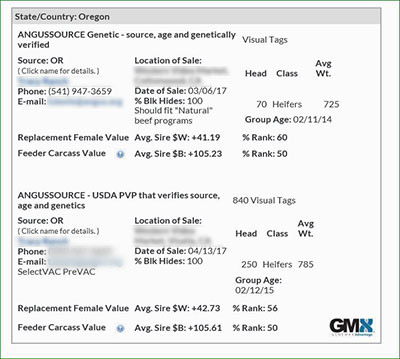 Ginette Gottswiller
Ginette GottswillerThe Source
Adding genomics adds value to commercial calves.
The familiar chant of the auctioneer encourages buyers to notice as another set of black-hided feeder calves enters the salering.
“Angus calves, boys, take a look. They’re CAB candidates.”
This cliché is used at every auction, every sale day.
What does a buyer want to know about your feeder calves when they enter the salering?
Documented data about genetics and health have generated added value at marketing for the past several years.
Verified health information during the summer of 2016 added value to the seller’s pocket from a rate of $2.16 to $13.16 per hundredweight (cwt.) on a load’s worth of lots of weaned feeder calves. Calves enrolled in a VAC 34, VAC 45 or VAC Precon walked away with those extra dollars.
The classic black calf walking into the salering today can be made from one or more breeds. It has become more difficult to pick out the Angus-influenced calves that yield a Certified Angus Beef® (CAB®) carcass on sale day.
How can you help buyers know your calves have an Angus base?
Enroll your next calf crop in AngusSource®, a marketing program that verifies enrolled calves are sired by a registered and transferred Angus bull. Producers go through an enrollment process and designate which Angus sires were used for the calf crop. Documentation includes the date of birth of the oldest calf and that all enrolled calves were born on their ranch. This verification process can be the driver to add extra dollars on sale day if the Marketing Document is completed.
The AngusSource Marketing Document was designed to give potential buyers as much information as the seller wants to convey. It lists the expected progeny differences (EPDs) of the sires used, vaccinations, group age, weaning date, where and when calves will be sold, as well as other management criteria potential buyers can use to make a purchasing decision.
The next step
The newest addition to add value to your commercial calf crop is genomics.
How can it benefit the commercial cow-calf producer? Using the results two ways gives benefits that can’t be ignored.
- 1. GeneMax® (GMX®) Advantage™ is intended for use on commercial females with 75% or greater Angus genetics.
- 2. Use the results to add value to your feeder calves.
- 3. Use the results to choose the best replacement heifers to keep in your herd.
Click here for example of Marketing Document with GMX information.
Click here for example of Marketing Document without GMX information.
Using genomic test results to help market your feeder calves using GMX Advantage has just been released to use on your AngusSource enrollment. Many progressive cattlemen are using the commercial genomic tests to make the best replacement-heifer selections and want to use the data to help market the steermates.

Email listings sent to 700 potential buyers of Angus genetics show average sire dollar values and percentile rankings for groups of calves. The GMX logo documents the added value that calves are DNA profiled.
If you test one-third of your enrollment group using either GMX Advantage or GMX Focus™, you have the option to add the scores to your feeder-calf document. This is a great way to show the actual value of your calf crop. AngusSource currently only shows the sire contribution to the calves and does not include a maternal component. Using the genomic information gives buyers the total picture — maternal plus paternal.
Do you think the initial test cost is too much? Recently, a producer tested 146 heifers. The producer chose his top 100 by visual appraisal. The score for that group was 56 points. Just a note, the producer did not test any heifers he had already culled for phenotype. The top 100 heifers chosen by GMX Advantage earned 65 points. By spreading the $39 test cost over the number of progeny that will be produced and potentially kept as replacement heifers, this producer has covered his test cost just on his replacement-heifer selection.
Utilizing a number of tools on your commercial Angus-based herd can yield positive profit results, along with other management practices. If you want to learn more about AngusSource or commercial genomic testing, give us a call at 816-383-5135 or visit www.angus.org.
 Editor's Note: Ginette Gottswiller is the director of commercial programs for the American Angus Association.
Editor's Note: Ginette Gottswiller is the director of commercial programs for the American Angus Association.
[Click here to go to the top of the page.]






